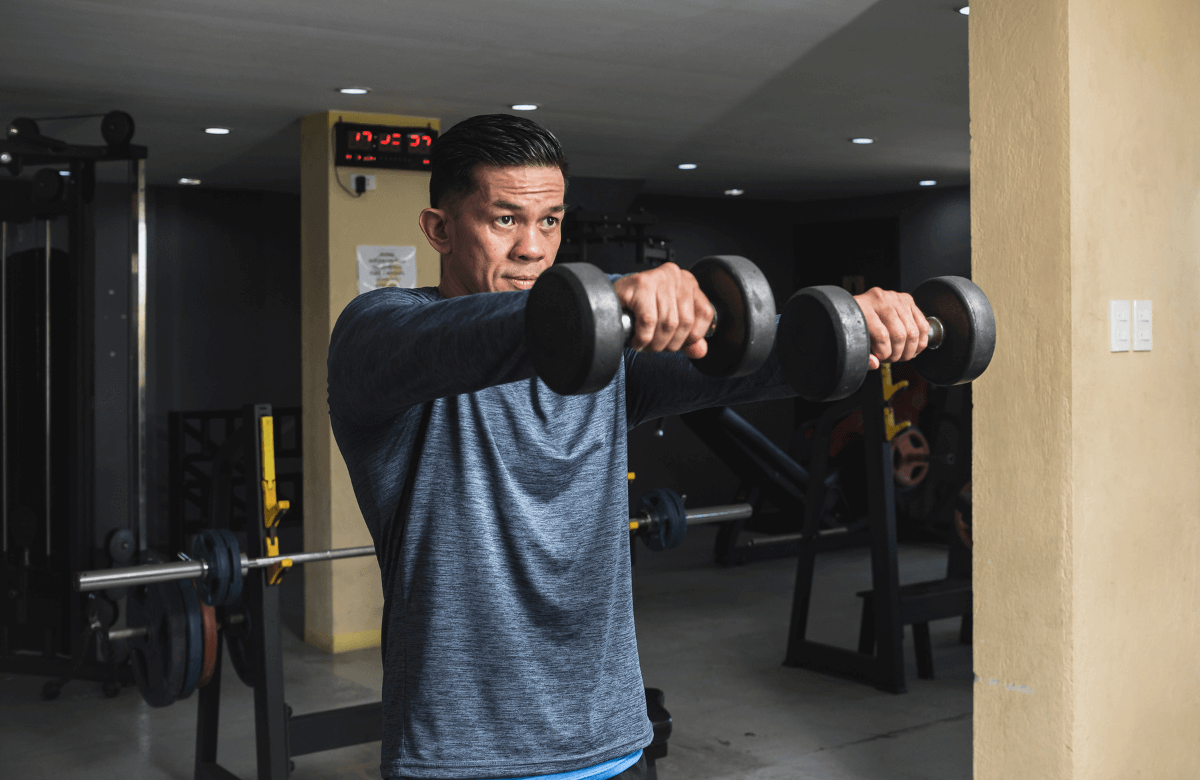Sleeve-popping shoulders like Arnold Schwarzenegger’s are a dream for many lifters. The shoulders are critical for an athletic physique and daily activities. You use the shoulders when you lift a box, throw a ball, or carry groceries in from the car.
That’s why training the shoulders is critical—not only so you look good but also feel good.
Front delt exercises should be a staple in your training program, as they can improve your strength, stability, mobility, and more. But where do you start? Which exercises will give you the most bang for your buck, and what equipment should you use?
We cover everything you need to know and more in the article below.
Jump to:
Deltoid Anatomy and Function
The first step is to understand deltoid muscle activation, anatomy, and function will assist you in getting the most out of your shoulder workouts. As you might assume, shoulder exercises target the shoulder muscles or the deltoids.
The deltoid muscle is a single muscle, but it has three specific muscle bellies or “deltoid heads,” including the following:
- Anterior (front) deltoids
- Lateral (side) deltoids
- Posterior (rear) deltoids
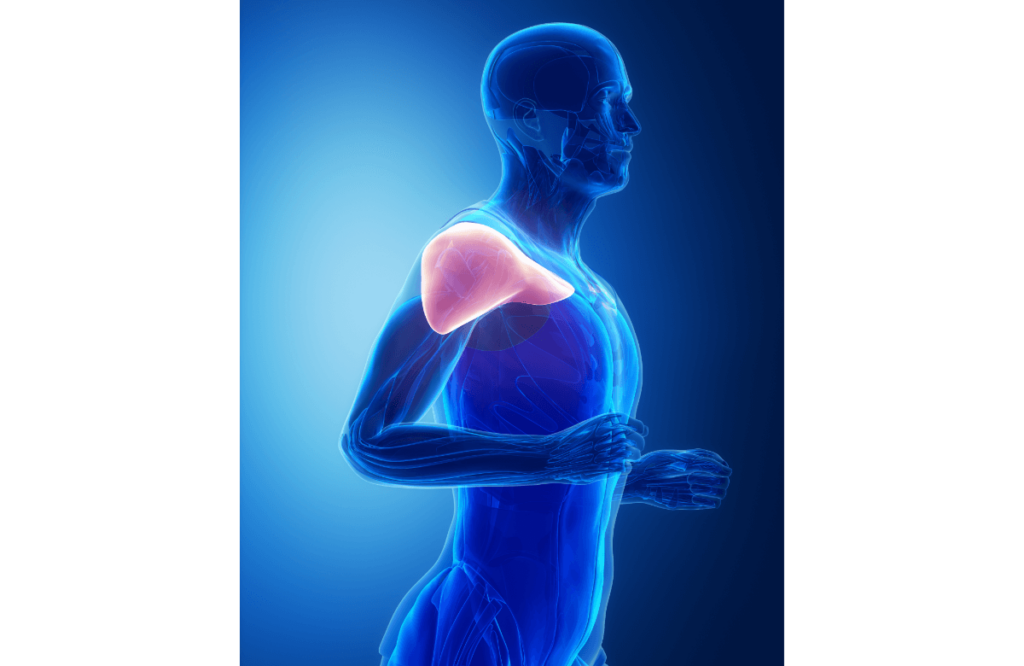
The different muscle heads begin at other areas around the shoulder and connect to form a single tendon, attaching to the upper arm bone. Each delt has a unique function, contributing to various shoulder joint functions.
Front Deltoid
Let’s start with the most prominent deltoid head and the focus of this article, the anterior or frontal deltoid. The front deltoid is located at the front of the shoulder. It’s activated during pressing movements, like shoulder presses, bench presses, and push-ups.
It’s used during shoulder flexion and internal rotation of the arm. You use the front delt when you lift something in front of your body, throw an object, or press something overhead.
Side Deltoid
The side or lateral deltoids are found on the exterior area of the shoulder. Sometimes called the middle delts, this muscle helps with shoulder abduction. This is when you lift the arm up and down, like in the lateral raise.
Strengthening your lateral deltoid can benefit other upper-body exercises, like overhead shoulder presses and flat bench presses. It helps to stabilize the shoulder joint, helping you maintain the correct alignment and support.
Rear Deltoid
Your posterior or rear deltoids are found on the backside of the muscle. The rear delts play a crucial role in the shoulder’s range of movement, balance, and overall posture.
The rear delts are most active when you pull the arm back, like skipping a rock or throwing a frisbee. It also helps with shoulder retraction, shoulder joint balance, and mobility.

The Benefits of Training Front Delts
You might wonder why you should go through the trouble of including front delt isolation exercises into your training program. Front delt workouts help you develop upper body strength, shoulder mobility, and a greater range of movement.
Deltoid exercises can suit nearly any fitness goal, whether building an aesthetically pleasing body or improving compound exercise like overhead shoulder presses.
Here are the top three reasons you should prioritize delt development and integrate deltoid workouts into your program.
More Upper Body Power
Delt exercises help you build more muscle mass in the shoulders. Building wider shoulders doesn’t just impact the type of clothes you wear. Building strength through deltoid workouts helps with posture, athletic performance, daily activities, and confidence.
Helps With Other Compound Exercises
The frontal deltoids are used in countless compound exercises, like the flat or incline bench press, OHP, and other variations.
These fundamental compound exercises are often the cornerstone of strength and progress. They’re used in many competition environments, like powerlifting, strongman, and CrossFit.
Strong deltoids will help you with these lifts, allowing you to push past plateaus, achieve new heights, and continue building strength.
Aesthetics
Let’s face it, many of us started our training programs with one goal in mind—to look good in the mirror.
There’s nothing wrong with wanting broader shoulders purely for aesthetics. In fact, following that goal is more likely to lead you to a healthier lifestyle with more energy, confidence, and fulfillment.
Deltoid workouts can help you build well-defined and strong anterior deltoids. This will help you create a more pleasing physique with stable, balanced, and wider shoulders.
Build Healthy Shoulders
A shoulder joint is a complex group of muscles, bones, tendons, and ligaments all working together. It has the greatest range of movement but has higher chances of injury, strain, and instability.
Front deltoid exercises can help you develop healthy shoulders. The frontal deltoid works with additional muscles to ensure the correct form and balance during activities.
You can strengthen the muscles through delt workouts, improving stability and reducing the chance of injuries, like shoulder impingement and overuse strains.
Better Functional Strength
Front deltoid workouts can boost your functional strength. You use functional strength daily when you lift something overhead, push on objects, or move things around.
Deltoid isolation exercises can enhance the shoulder’s strength, mobility, and balance. This will give you an easier time in a wide range of activities and reduce the chance of strain.
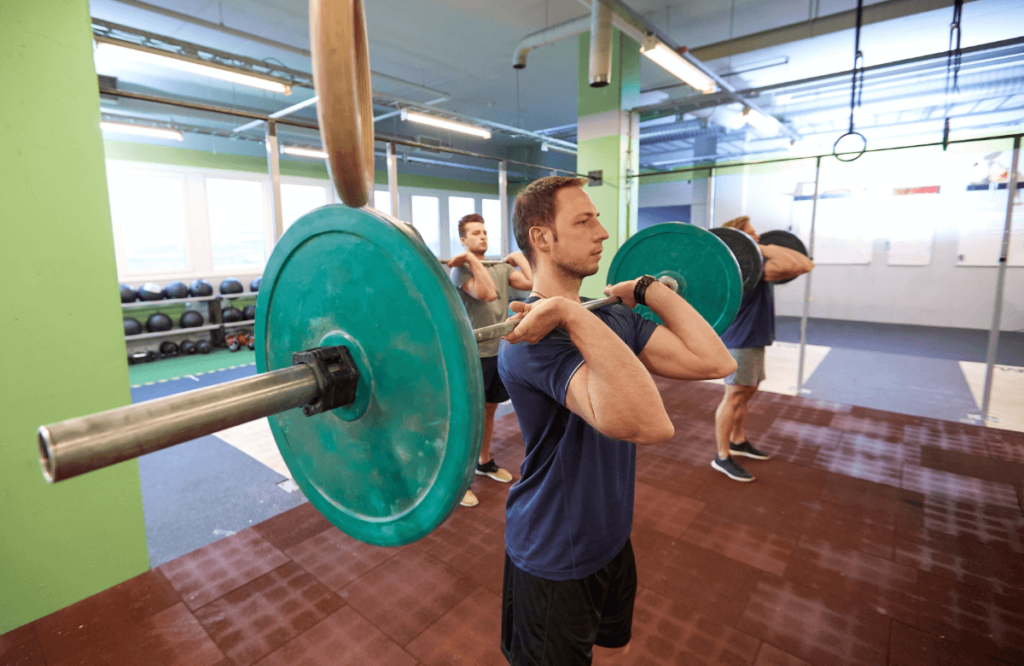
What Are The Best Front Delt Exercises?
You can use a wide variety of exercises and equipment for muscle growth. But which pieces of equipment are best for shoulder workouts? What will give you the most balanced shoulder development?
Here’s a look at the most popular pieces of equipment for deltoid exercises and front delt development.
When to Use Barbells
Barbell shoulder movements can be effective for building deltoid muscles. The traditional bench press, incline bench press, overhead press, and other variations are foundational for building shoulder muscles.
- Use compound movements, like the barbell overhead press and bench press, as the foundation of your shoulder workouts.
- Use a barbell with heavier weights if you’re trying to build strength and power in the shoulders.
- Use barbell compound upper-body exercises if you’re looking for a time-efficient way to train the shoulders.
- Use a barbell to easily increase the weight gradually, helping you get stronger over time.
The barbell’s greater weight capacity and balance allow you to use heavier weights and challenge the frontal deltoids more. Overall, you should incorporate barbell deltoid exercises as a core component of your training program.
When to Use Dumbbells
Dumbbell exercises can yield substantial results when it comes to front delt isolation exercises. You can use a pair of dumbbells to target the entire shoulder, including middle delts and posterior deltoids.
- Use dumbbells for unilateral movements to address muscle imbalances and provide balanced activation in your shoulder routine.
- Incorporate dumbbells for isolated deltoid exercises to ensure a balanced shoulder workout.
- Use dumbbells if you have a limited range of motion and want to improve flexibility, stability, and coordination.
- Include dumbbell delt isolation exercises as a way to improve your core stability and strength.
- Use dumbbell shoulder exercises to add variety to your training routine and challenge the muscles in a new way.
When you use dumbbells, each arm has to work independently. This helps you fix any muscle imbalances between your left and right sides, ensuring they become equally strong.
Dumbbells also activate smaller supporting muscles in the shoulder joint, helping you develop more shoulder mobility and stability. With a wide variety of workouts, you can continuously challenge the muscles in fresh ways.
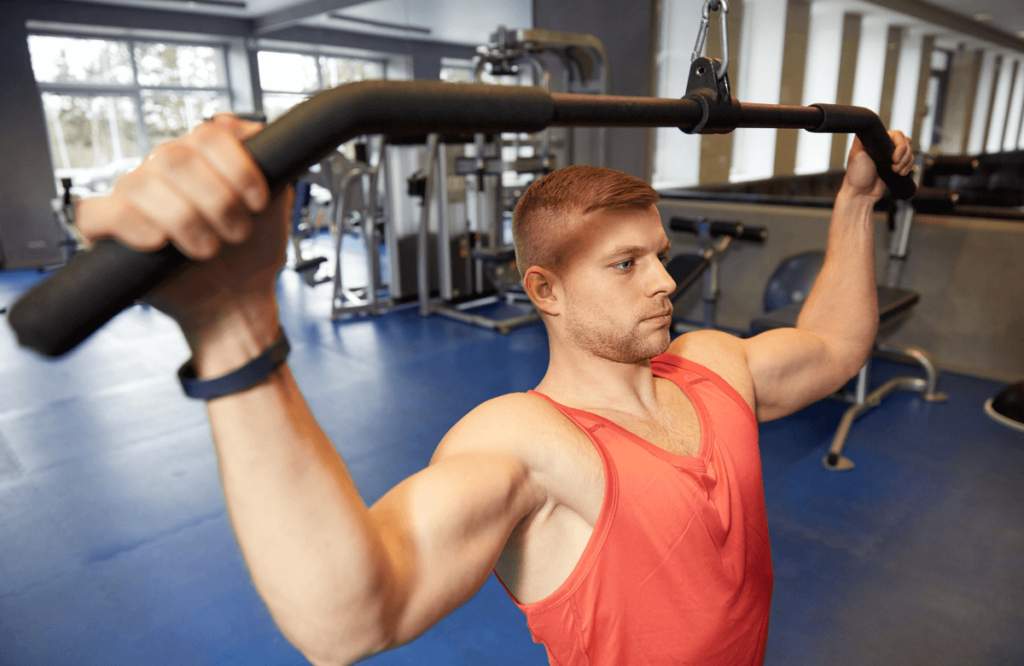
When to Use Cable Machines
The cable machine is an excellent piece of equipment you can use to focus on your deltoid muscles. The cable pulley machine provides consistent resistance over time, meaning the muscles are challenged through the lighting and lowering phase.
- Use the cable pulley machine as a way to add volume to your deltoid exercises.
- Incorporate lightweight, high-rep deltoid exercises to build endurance and muscle hypertrophy.
- Use the cable pulley machine to place less stress on the joints, allowing you to improve stability, mobility, and range of motion.
- Include cable pulley machine deltoid exercises like the cable upright row to add variations to your training regimen.
Using the cable pulley machine in your workouts has several benefits. It keeps tension on your muscles, has adjustable resistance levels, provides lots of exercise choices, and also engages supportive muscles throughout the core.
When to Use Resistance Bands
Similar to the cable pulley machine, resistance bands offer similar benefits for deltoid exercises, like consistent resistance over time. Exercise bands are a cost-effective way to train your body and can be incredibly useful under the right circumstances.
- Use resistance bands if you don’t have access to a cable pulley machine or other pieces of equipment.
- Include resistance band workouts as a way to warm up or finish a balanced shoulder workout.
- Use resistance bands if you’re new to lifting and need a way to progress toward heavier weights.
- Incorporate resistance bands as a way to improve shoulder stability and mobility alongside core strength.
- Select resistance bands if you’re recovering from injuries or strain.
- Use resistance bands for low-impact deltoid exercises to place less stress on the joints.
Incorporating resistance bands into your front deltoid workouts not only helps you target the anterior delts effectively but also enhances shoulder stability, strengthens supporting muscles, and provides a convenient training solution.
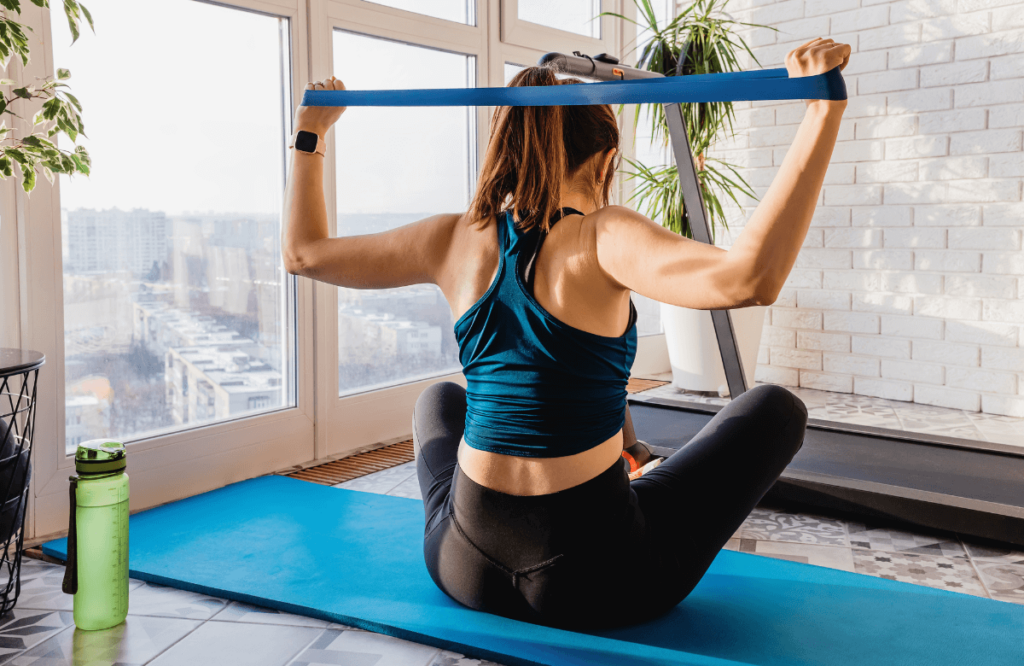
When to Use Body Weight
Building strength doesn’t require fancy equipment. Incorporating your entire body weight can help you tone your shoulders, developing strength, size, and muscle mass. There are countless exercises you can perform nearly anywhere.
- Use bodyweight exercises if you don’t have access to any equipment or training facilities.
- Incorporate bodyweight training as a warm-up or cool-down after a balanced shoulder workout.
- Include bodyweight exercises in circuit training to increase volume and demand.
- Use bodyweight exercises as a way to progress and work your way up to more challenging weights.
As a low-impact option, bodyweight workouts are practical exercises if you’re recovering from previous injuries or don’t have access to pieces of equipment.
What Rep Range and Training Frequency?
You might wonder, “How many shoulder days should I have each week?” Or you might wonder, “How many rest days do I need, and can I use heavy loads for my front deltoids?” Don’t worry; we got you covered.
Rep Range
The rep range you use for a muscle group depends on the exercise and your fitness goals.
- For compound, multi-joint exercises, use lower rep ranges between 8–12. Exercises like the overhead shoulder press and incline bench press are perfect for loading more weight plates and building strength.
- For isolation, single joint exercises, use higher ranges of 10–12 reps or 12–15. Exercises like the front raise work better with lightweight, as you’re focusing on muscle endurance and time under tension.
Using heavier loads than necessary during isolation exercises can lead to strain, injury, poor technique, and long recovery times.
Training Frequency
The training frequency will depend on your fitness level, plan, life, and goals.
- Train your shoulders 1–2 times a week with at least one rest day in between. Going overboard on one muscle group can be counterproductive, leading to overuse, injury, and slow muscle growth.
- Start with at least 30 seconds of rest between sets. Unless you’re completing tempo exercises, it’s essential to give your muscles adequate rest periods between each set for recovery.
Your training frequency will depend significantly on your fitness level, circumstances, and goals. You might not have time to train the shoulders twice a week or may not have the energy. Always pay attention to your body and adjust accordingly.
Barbell Exercises
Barbell Overhead Shoulder Press
Barbell overhead shoulder presses are an important exercise that works many muscles and helps you get stronger by using heavy weights. There is more core engagement with the standing variation, which is useful for increasing stability.
- The standing barbell overhead press engages multiple muscle groups, including the shoulders, triceps, upper back, and core, providing a full-body workout for improved strength and stability.
- By simulating real-life movements, such as pushing objects overhead, this exercise develops functional strength that translates into better performance in daily activities and sports.
- The standing barbell overhead press challenges and strengthens the abdominal muscles, promoting stability and good posture while reducing the risk of back injuries.
Incline Bench Press
Incline Bench Presses are a chest exercise, but it also uses the front shoulders and triceps. It’s a compound exercise, which means it uses numerous muscle groups at once. Chest press exercises can be beneficial for targeting the front delts if you use a higher bench angle.
- The incline bench press targets the upper chest, shoulders, and triceps, helping to develop well-rounded upper body strength and definition.
- Adjusting the bench to an inclined position this exercise places more emphasis on the upper chest muscles, contributing to a balanced and aesthetic physique. You can engage the shoulders more with a 45-degree angle.
- Incline bench press also helps improve shoulder stability and mobility, making it beneficial for athletes involved in sports that require overhead movements, such as basketball or volleyball.
Landmine Overhead Press
The Landmine Overhead Press is a multi-joint exercise that works your entire upper body. It’s not as well-known as other exercises, possibly because some people are unfamiliar with the equipment. This exercise is done in standing, which helps improve your core balance and strength.
- The landmine overhead press is a versatile exercise that engages the shoulders, triceps, and core muscles, providing a comprehensive upper-body workout.
- By utilizing the landmine apparatus, this exercise offers a more joint-friendly pressing movement compared to traditional overhead presses, reducing stress on the shoulder joints.
- The landmine overhead press enhances functional strength by mimicking real-life pushing and pressing movements, making it beneficial for improving everyday activities and sports performance.
Dumbbell Exercises
Arnold Press
The Arnold Press is an exercise popularized by the renowned Arnold Schwarzenegger. It’s an excellent choice for working your shoulder muscles. Adding the rotation in this exercise targets all parts of your shoulders, which can lead to significant growth.
- The Arnold press is a dynamic shoulder exercise that targets multiple muscle groups, including the shoulders, triceps, and upper back, leading to improved upper body strength and definition.
- By incorporating rotation into the movement, the Arnold press activates the deltoids from different angles, promoting balanced muscle development and enhancing shoulder stability.
- The Arnold press can help improve the range of motion and flexibility in the shoulders, making it a valuable exercise for athletes and individuals seeking to enhance their overhead movements and mobility.
Dumbbell Front Raise
The Dumbbell Front Raise is a highly effective exercise for targeting the front part of your shoulders. It’s best to use moderate weights and aim for a higher number of repetitions.8-12 reps is a good range to build endurance and muscle size. This exercise also engages your core muscles to maintain a sturdy body position when standing.
- The dumbbell front raises primarily target the front deltoids, helping to build strong and defined shoulders.
- This exercise also engages the trapezius and upper chest muscles, contributing to a well-rounded upper body appearance.
- The dumbbell front raise is a simple and effective movement that improves shoulder stability and enhances posture, making it a valuable exercise for overall upper body strength and aesthetics.
Incline Dumbbell Bench Press
Incline Dumbbell Presses are a modification of the conventional barbell press. Although it may appear to primarily target the chest muscles, it’s an amazing variation for working the pectoralis major and anterior delts. Performing incline presses with dumbbells requires coordination and strength from the stabilizer muscles, which can lead to increased muscle growth.
- The incline dumbbell bench press exercise offers an increased range of motion compared to the barbell variation, allowing for better chest muscle activation and development.
- By using dumbbells, this exercise engages each arm independently, promoting muscular balance and addressing strength imbalances between sides.
- The incline dumbbell bench press also provides a greater challenge to the stabilizer muscles, particularly in the shoulders and core, leading to improved overall stability and functional strength.
Cable Machine Exercises
Front Cable Raise
The Cable Front Raise exercise is a modification of the free weight variant. Using a cable pulley machine provides consistent tension throughout the movement, which activates more muscles and makes it a fantastic isolation workout. It’s recommended to perform this exercise in the 8-15 repetitions range with a moderate weight.
- The front cable raise is a shoulder exercise that targets the front deltoids, helping to develop strength and definition in the shoulders.
- Using a cable machine provides constant tension throughout the movement, leading to effective muscle activation and stimulation.
- The front cable raise allows for a wide range of motion and offers variations in grip and cable attachment, enabling individuals to target different areas of the shoulder muscles and customize their workout.
Upright Row
The Upright Row is an excellent exercise for developing the upper body, including the front delts and arms. When using the cable machine, you can choose from various grip widths, which change the movement pattern based on which muscles you want to activate.
- The cable upright row is an effective exercise for targeting the muscles of the upper back, shoulders, and trapezius.
- Using a cable machine allows for a smooth and controlled motion, providing constant tension on the muscles throughout the exercise.
- The cable upright row offers versatility by allowing for various grip options and adjustments in cable height, enabling individuals to target different areas of the upper body and tailor their workout to their specific needs.
Resistance Bands
Overhead Pull Apart
Resistance Band Overhead Pull-Aparts is an effective exercise that engages the upper back and shoulder muscles, leading to improved posture, shoulder stability, and increased upper body strength. This exercise specifically targets the muscles responsible for pulling movements, helping to enhance daily functional strength.
- The resistance band overhead pull-apart is a fantastic exercise for targeting the muscles of the upper back, shoulders, and rear deltoids.
- Using a resistance band provides adjustable resistance throughout the movement, allowing for progressive overload and muscle strength development.
- The overhead pull-apart with a resistance band helps improve shoulder stability and posture, making it a beneficial exercise for reducing the risk of shoulder injuries and enhancing overall upper body strength and aesthetics.
Forward Raise
The Resistance Band Forward Raise is an excellent choice to isolate and target the anterior deltoids effectively. This variation helps build fuller shoulders, enhances stability, and promotes balanced muscle development compared to other variations.
- The resistance band forward raise is a shoulder exercise that specifically targets the front deltoids, contributing to improved shoulder strength and definition.
- Using a resistance band adds variable resistance, providing a challenging workout at both the bottom and top of the movement, unlike traditional dumbbell raises.
- The resistance band forward raise allows for a more natural movement pattern, reducing strain on the joints and potentially minimizing the risk of injury, especially when compared to using heavy dumbbells or barbells.
Overhead Press
The Resistance Band Overhead Press is excellent for improving shoulder strength, stability, and range of movement. It specifically targets the muscles of the shoulders, triceps, and upper back while engaging the core for added stability and balance.
- The resistance band overhead press is an effective shoulder exercise that targets the deltoids, triceps, and upper back muscles, promoting overall upper body strength and stability.
- Using a resistance band adds variable resistance throughout the movement, allowing for a more challenging workout as the band tension increases at the top of the press.
- The resistance band overhead press offers a greater range of motion and more freedom of movement compared to traditional barbell or dumbbell overhead presses, making it a versatile exercise option that can be easily adjusted to individual preferences and limitations.
- The resistance band overhead press is generally considered to be more joint-friendly, reducing the stress on the shoulder joints and potentially lowering the risk of injury.
Bodyweight Exercises
Push-Up
The Push-Up is an excellent bodyweight movement for your workout routine. It can be done anywhere and helps build strength in your pecs, shoulders, and arms.
- Push-ups effectively engage the front deltoids, helping to develop strength and definition in the shoulder muscles.
- The push-up is a bodyweight exercise that can be performed anywhere without the need for equipment, making it a convenient and accessible option for targeting the front deltoids.
- Push-ups also engage other muscle groups, including the chest, triceps, and core, providing a compound movement that promotes overall upper body strength and stability.
Pike Push-Ups
Pike Push-Ups are a variation that can enhance upper body power and balance. This exercise involves an upright stance, which targets the triceps and shoulders.
- Pike push-ups specifically target the front deltoids, providing a focused and intense workout for these shoulder muscles.
- This exercise involves a high degree of shoulder flexion, allowing for a greater range of motion compared to traditional push-ups and further emphasizing the front deltoids.
- Pike push-ups also engage the triceps, upper back, and core muscles, providing a compound movement that strengthens multiple muscle groups simultaneously, leading to improved upper body strength and stability.
Dips
The Parallel Bar Dip is a compound exercise that mainly focuses on the chest, triceps, and front shoulder muscles. It involves using parallel bars, suspending your body in the air, and using your arms to lower and raise yourself.
- Parallel bar dips are an effective exercise for targeting the front deltoids, along with the triceps and chest muscles, helping to develop strength and definition in the upper body.
- By utilizing parallel bars, this exercise allows for a greater range of motion compared to traditional dips, enabling a deeper contraction of the front deltoids and increased muscle activation.
- Parallel bar dips also engage the stabilizer muscles, including the core and upper back, promoting overall upper body stability and strength. They offer a challenging bodyweight exercise option that can be modified to suit different fitness levels by adjusting the body angle or adding additional weight.
Frequently Asked Questions (FAQ)
What Movements target the anterior Delts?
Exercises where you lift something overhead, press something away from the body, or lift something straight in front of the torso train the front deltoids. These exercises include the overhead shoulder press, incline bench press, and front deltoid raise.
What Is the Best Way to Build Front Delts?
The best way to build the frontal deltoids is to incorporate compound and isolation exercises. Compound, multi-joint movements like the overhead and incline bench press should be your bread and butter. Accessory lifts like the front raise can add volume and ensure balanced shoulder development.
What Is the Best Angle for a Front Delt?
If you’re trying to target the anterior delts through the Incline Bench Press, it’s best to use a 45-Degree angle. Setting an adjustable bench angle to 45-degrees will engage the shoulders more than the upper chest.



